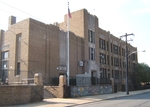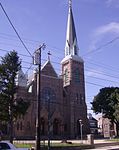Holme Avenue Bridge
Arch bridges in the United StatesBridges on the National Register of Historic Places in PhiladelphiaConcrete bridges in PennsylvaniaNortheast PhiladelphiaPennsylvania bridge (structure) stubs ... and 3 more
Philadelphia County, Pennsylvania Registered Historic Place stubsRoad bridges in PennsylvaniaRoad bridges on the National Register of Historic Places in Pennsylvania

The Holme Avenue Bridge is a closed-spandrel concrete arch bridge that carries Holme Avenue across Wooden Bridge Run (a tributary of Pennypack Creek) in Philadelphia, Pennsylvania. The total length of the bridge is 101.1 feet (30.8 m). The width of its deck is 83.8 feet (25.5 m). Built in 1921, it remains in use today. The bridge was listed on the National Register of Historic Places in 1988.It should not to be confused with the other "Holme Avenue Bridge" over Pennypack Creek about 1,000 yards west of Wooden Bridge Run.
Excerpt from the Wikipedia article Holme Avenue Bridge (License: CC BY-SA 3.0, Authors, Images).Holme Avenue Bridge
Holme Avenue, Philadelphia
Geographical coordinates (GPS) Address Nearby Places Show on map
Geographical coordinates (GPS)
| Latitude | Longitude |
|---|---|
| N 40.056388888889 ° | E -75.023333333333 ° |
Address
Holme Avenue
Holme Avenue
19114 Philadelphia
Pennsylvania, United States
Open on Google Maps







